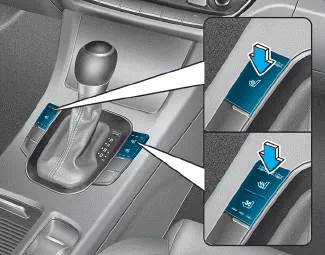Hyundai i30 (PD): Seats / Seat warmers and air ventilation seats
Front seat warmers
Seat warmers are provided to warm the seats during cold weather.
WARNING
The seat warmers can cause a SERIOUS BURN, even at low temperatures and especially if used for long periods of time. Passengers must be able to feel if the seat is becoming too warm so they can turn it off, if needed. People who cannot detect temperature change or pain to the skin should use extreme caution, especially the following types of passengers:
- Infants, children, elderly or disabled persons, or hospital outpatients.
- People with sensitive skin or who burn easily.
- Fatigued individuals.
- Intoxicated individuals.
- People taking medication that can cause drowsiness or sleepiness.
WARNING
NEVER place anything on the seat that insulates against heat when the seat warmer is in operation, such as a blanket or seat cushion. This may cause the seat warmer to overheat, causing a burn or damage to the seat.
NOTICE
To prevent damage to the seat warmers and seats:
- Never use a solvent such as paint thinner, benzene, alcohol or petrol to clean the seats.
- Do not place heavy or sharp objects on seats equipped with seat warmers.
- Do not change the seat cover. It may damage the seat warmer.

Whilst the engine is running, push either of the switches to warm the driver's seat or front passenger's seat.
During mild weather or under conditions where the operation of the seat warmer is not needed, keep the switches in the OFF position.
- Each time you push the switch, the
temperature setting of the seat is
changed as follows :

- When pressing the switch for more than 1.5 seconds with the seat warmer operating, the seat warmer will turn OFF.
- The seat warmer defaults to the OFF position whenever the ignition switch is placed to the ON position.
Information
With the seat warmer switch in the ON position, the heating system in the seat turns off or on automatically depending on the seat temperature.
The rear seats are equipped with head restraints in all the seating positions for the passenger’s safety and comfort. Adjusting the height up and down To raise the head restraint: 1.
The air ventilation seats are provided to cool the front seats by blowing air through small vent holes on the surface of the seat cushions and seatbacks.
Other information:
Hyundai i30 (PD) 2018-2024 Owner's Manual: Tyre rotation
To equalize tread wear, HYUNDAI recommends that the tyres be rotated every 7,500 miles (12,000 km) or sooner if irregular wear develops. During rotation, check the tyres for correct balance. When rotating tyres, check for uneven wear and damage.
Hyundai i30 (PD) 2018-2024 Owner's Manual: Selective Catalytic Reduction
The Selective Catalytic Reduction (SCR) system is to catalytically convert NOx to Nitrogen and Water by using the reduction agent, the urea solution. Urea gauge The urea solution gauge indicates the approximate amount of remaining urea solution inside the urea solution tank.
Categories
- Manuals Home
- Hyundai i30 Owners Manual
- Exhaust System (DPF) Warning Light. Glow Indicator Light
- Driving your vehicle
- Maintenance
- New on site
- Most important about car
